
 TECHSPEC® components are designed, specified, or manufactured by Edmund Optics. Learn More
TECHSPEC® components are designed, specified, or manufactured by Edmund Optics. Learn More
| Prix sur Quantité | |
|---|---|
| Qté 1-5 | €54,08 prix unitaire |
| Qté 6-25 | €43,26 prix unitaire |
| Qté 26-49 | €40,69 prix unitaire |
| Need More? | Demande de Devis |
Les Prismes à Coins en N-BK7 peuvent être utilisés individuellement pour faire dévier un faisceau laser à un angle établi, ou deux prismes à coins peuvent être utilisés pour changer la direction d'un faisceau. La capacité d'un seul prisme à coins de dévier l'angle d'un faisceau incident est mesurée en Dioptres, avec 1 dioptre déviant le faisceau de 1 cm à une distance de travail de 1 m.
Deux Prismes à Coins peuvent être utilisés comme une paire anamorphique pour former un nouveau faisceau (pour corriger la forme elliptique des sorties diode par exemple). Une paire de Prismes à Coin peut également orienter un faisceau n'importe où sur un cercle décrit par l'angle complet 4xθ où θ est l'angle de déviation d'un seul prisme. Cette orientation du faisceau s'opère en faisant pivoter les deux Prismes à Coin sur eux-mêmes indépendamment l'un de l'autre. Ce qui est généralement utilisé pour balayer un faisceau à différents endroits pour des applications en imagerie.
Remarque : Le changement de direction d’un faisceau est indiqué en degrés et en dioptres. 1 dioptre correspond à une déviation de faisceau de 1 cm à une distance d’1 m du prisme.
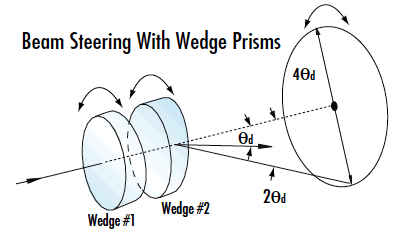
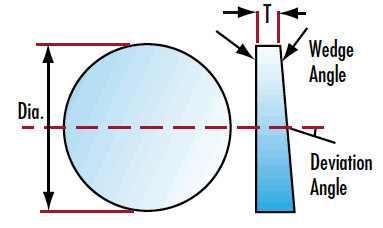
| N-BK7 | |
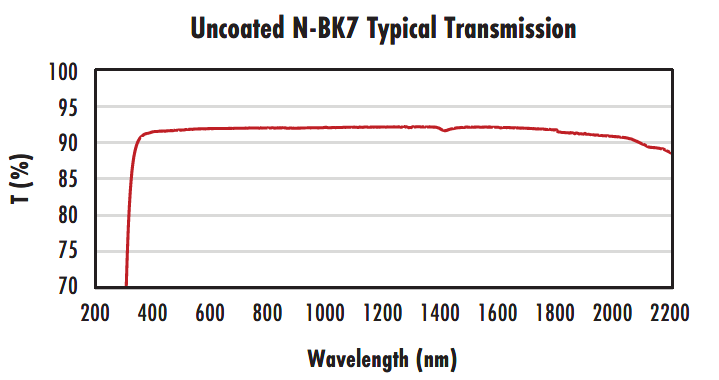 |
Typical transmission of a 3mm thick, uncoated N-BK7 window across the UV - NIR spectra. |
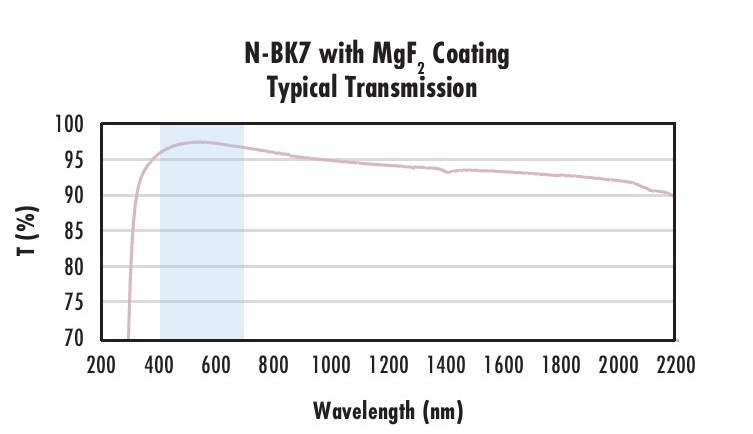 |
Typical transmission of a 3mm thick N-BK7 window with MgF2 (400-700nm) coating at 0° AOI. The blue shaded region indicates the coating design wavelengh range, with the following specification: Ravg ≤ 1.75% @ 400 - 700nm (N-BK7) Data outside this range is not guaranteed and is for reference only. |
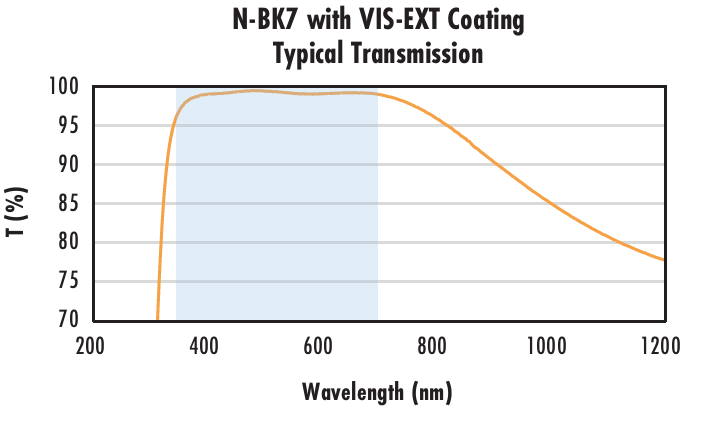 |
Typical transmission of a 3mm thick N-BK7 window with VIS-EXT (350-700nm) coating at 0° AOI. The blue shaded region indicates the coating design wavelengh range, with the following specification: Ravg ≤ 0.5% @ 350 - 700nm Data outside this range is not guaranteed and is for reference only. |
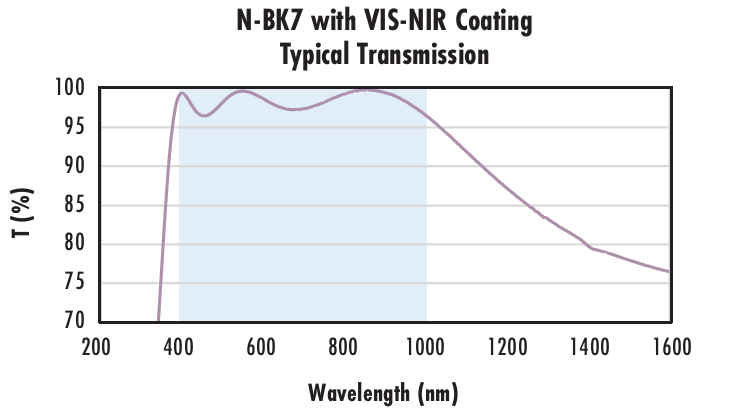 |
Typical transmission of a 3mm thick N-BK7 window with VIS-NIR (400-1000nm) coating at 0° AOI. The blue shaded region indicates the coating design wavelengh range, with the following specification: Rabs ≤ 0.25% @ 880nm Data outside this range is not guaranteed and is for reference only. |
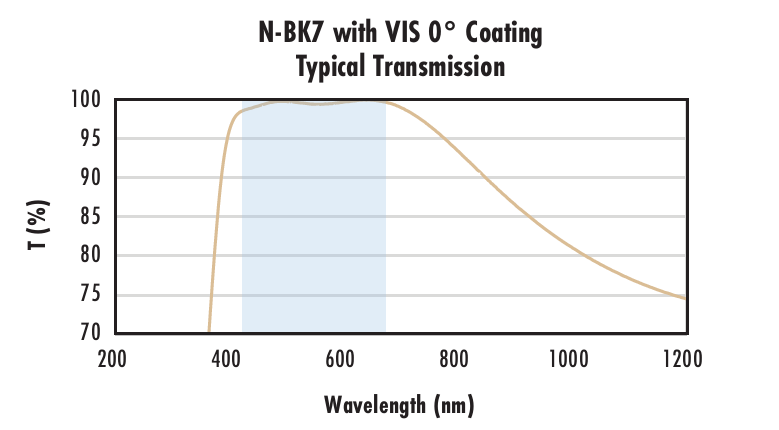 |
Typical transmission of a 3mm thick N-BK7 window with VIS 0° (425-675nm) coating at 0° AOI. The blue shaded region indicates the coating design wavelengh range, with the following specification: Ravg ≤ 0.4% @ 425 - 675nm Data outside this range is not guaranteed and is for reference only. |
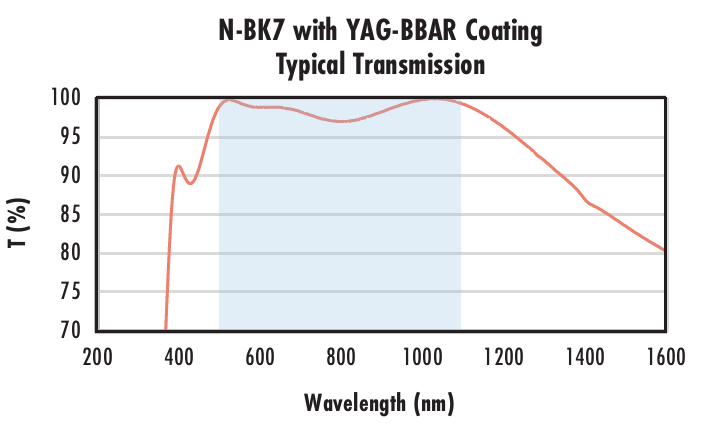 |
Typical transmission of a 3mm thick N-BK7 window with YAG-BBAR (500-1100nm) coating at 0° AOI. The blue shaded region indicates the coating design wavelengh range, with the following specification: Rabs ≤ 0.25% @ 532nm Data outside this range is not guaranteed and is for reference only. |
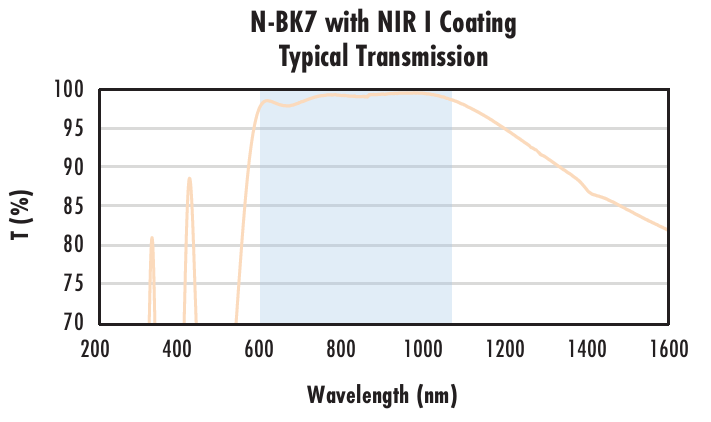 |
Typical transmission of a 3mm thick N-BK7 window with NIR I (600 - 1050nm) coating at 0° AOI. The blue shaded region indicates the coating design wavelengh range, with the following specification: Ravg ≤ 0.5% @ 600 - 1050nm Data outside this range is not guaranteed and is for reference only. |
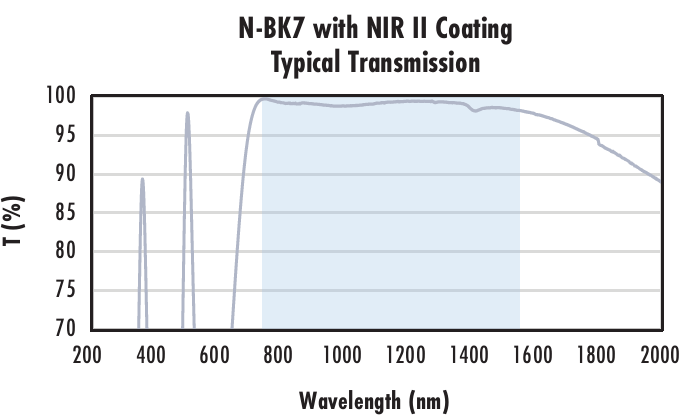 |
Typical transmission of a 3mm thick N-BK7 window with NIR II (750 - 1550nm) coating at 0° AOI. The blue shaded region indicates the coating design wavelengh range, with the following specification: Rabs ≤ 1.5% @ 750 - 800nm Data outside this range is not guaranteed and is for reference only. |
Edmund Optics propose des services complets de fabrication personnalisée de composants optiques et d'imagerie adaptés aux exigences de vos applications spécifiques. Qu'il s'agisse de la phase de prototypage ou de la préparation d'une production à grande échelle, nous proposons des solutions flexibles pour répondre à vos besoins. Nos ingénieurs expérimentés sont là pour vous aider, de la conception à la réalisation.
Nos capacités comprennent :
En savoir plus sur nos capacités de fabrication sur mesure ou soumettre une demande ici.
ou consulter les numéros d’autres pays
facile à utiliser
entrer les numéros de stock pour commencer
Copyright 2023 | Edmund Optics, Ltd Unit 1, Opus Avenue, Nether Poppleton, York, YO26 6BL, UK
POLITIQUE DE CONFIDENTIALITÉ | POLITIQUE DE COOKIES | CONDITIONS GÉNÈRALES | CONDITIONS GÉNÈRALES B2C | MENTIONS LÉGALES | ACCESSIBILITÉ
L'entreprise Edmund Optics GmbH en Allemagne agit comme un mandataire d'Edmund Optics BV aux Pays-Bas.
Le titulaire du contrat est Edmund Optics BV aux Pays-Bas.
The FUTURE Depends On Optics®